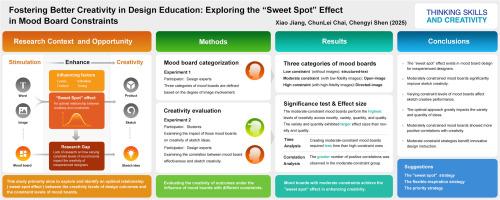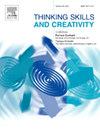Fostering better creativity in design education: Exploring the “sweet spot” effect in mood board constraints
IF 4.5
2区 教育学
Q1 Social Sciences
引用次数: 0
Abstract
Modern design education requires innovative approaches to inspire and enhance creativity. Prior research suggests that cognitive stimulation levels significantly influence creative performance, with an optimal level known as the “sweet spot” effect. However, studies specifically addressing inexperienced designers remain limited. While mood boards are commonly used as visual stimuli in design processes, few studies, particularly in educational contexts, have explored the optimal level of stimulation. This gap may stem from challenges such as novice users’ limited expertise and the absence of refined instructional strategies. This controlled experiment aimed to explore whether an optimal level of stimulation exists in mood board design activities. Participants were classified into low-, moderate-, and high-constraint groups based on the degree of image involvement. The study employed the sweet spot framework, treating creativity level as the dependent variable and constraint level as the independent variable. Creativity in design sketches was evaluated across four dimensions: novelty, variety, quality, and quantity. Mood board effectiveness was subjectively assessed using three criteria: innovation, consistency, and visual attractiveness. The results indicated that the moderate-constraint group proved most effective in stimulating creativity across these four metrics. They also required less creation time than the high-constraint group. Moreover, moderately constrained mood boards demonstrated the largest number of significant positive correlations with sketch creativity. Furthermore, the study identified the characteristics of mood boards with low and high constraint levels. Based on these findings, this study proposes practical instructional strategies to foster creative education using mood boards.

在设计教育中培养更好的创造力:探索情绪板约束下的“最佳点”效应
现代设计教育需要创新的方法来激发和增强创造力。先前的研究表明,认知刺激水平显著影响创造性表现,最佳水平被称为“最佳点”效应。然而,专门针对缺乏经验的设计师的研究仍然有限。虽然情绪板通常被用作设计过程中的视觉刺激,但很少有研究,特别是在教育背景下,探索了最佳刺激水平。这种差距可能源于诸如新手用户的专业知识有限和缺乏完善的教学策略等挑战。本对照实验旨在探讨情绪板设计活动中是否存在最佳刺激水平。参与者根据图像涉入程度分为低约束组、中等约束组和高约束组。本研究采用最佳点框架,以创造力水平为因变量,约束水平为自变量。设计草图的创造力从四个方面进行评估:新颖性、多样性、质量和数量。情绪板的有效性通过三个标准进行主观评估:创新、一致性和视觉吸引力。结果表明,中度约束组在这四个指标中最有效地激发了创造力。他们也比高约束组需要更少的创建时间。此外,适度约束的情绪板显示出与素描创造力显著正相关的最大数量。此外,该研究还确定了低约束水平和高约束水平的情绪板的特征。基于这些发现,本研究提出了使用情绪板促进创造性教育的实用教学策略。
本文章由计算机程序翻译,如有差异,请以英文原文为准。
求助全文
约1分钟内获得全文
求助全文
来源期刊

Thinking Skills and Creativity
EDUCATION & EDUCATIONAL RESEARCH-
CiteScore
6.40
自引率
16.20%
发文量
172
审稿时长
76 days
期刊介绍:
Thinking Skills and Creativity is a new journal providing a peer-reviewed forum for communication and debate for the community of researchers interested in teaching for thinking and creativity. Papers may represent a variety of theoretical perspectives and methodological approaches and may relate to any age level in a diversity of settings: formal and informal, education and work-based.
 求助内容:
求助内容: 应助结果提醒方式:
应助结果提醒方式:


